Abstract
The Content-Centric Network (CCN) presents an alternative to the conventional TCP/IP network, where IP is fundamental for communication between the source and destination. Instead of relying on IP addresses, CCN emphasizes content to enable efficient data distribution through caching and delivery. The increasing demand of graphic-intensive applications requires minimal response time and optimized resource utilization. Therefore, the CCN plays a vital role due to its efficient architecture and content management approach. To reduce data retrieval delays in CCNs, traditional methods improve caching mechanisms through clustering. However, these methods do not address the optimal use of resources, including CPU, memory, storage, and available links, along with the incorporation of social awareness. This study proposes SARAC4N, a socially and resource-aware caching framework for clustered Content-Centric Networks that integrates dual-head clustering and popularity-driven content placement. It enhances caching efficiency, reduces retrieval delays, and improves resource utilization across heterogeneous network topologies. This approach will help resolve congestion issues while enhancing social awareness, lowering error rates, and ensuring efficient content delivery. The proposed Socially and Resource-Aware Caching in Clustered Content-Centric Network (SARAC4N) enhances caching effectiveness by optimally utilizing resources and positioning them with social awareness within the cluster. Furthermore, it enhances metrics such as data retrieval time, reduces computation and memory usage, minimizes data redundancy, optimizes network usage, and lowers storage requirements, all while maintaining a very low error rate.
1. Introduction
The existing internet architecture primarily depends on the network layer, specifically the Internet Protocol (IP), which serves as the central mechanism to establish connectivity between nodes. It provides identification or addressability of the content to be accessed or routed when requested [1]. The traditional network protocol suite has evolved with substantial improvements at both the upper and lower layers surrounding the IP layer. Over time, technology has advanced significantly, as have the devices involved, such as handheld equipment [2]. Similarly, communication between peers in peer-to-peer (P2P) systems and the Internet of Things (IoT), which includes billions of interconnected devices, has also evolved and increasingly incorporates social factors [3,4,5]. With so much advancement, the major point of concern is to stabilize the network against fragility and resiliency, ensuring efficient data retrieval times along with its distributed nature. Named Data Networking (NDN) operates on Interest and Data packets. Consumers send Interest packets requesting data by name. The request is forwarded through routers that maintain Pending Interest Tables (PITs). Once the data is found in cache or from the source, it is returned to the requester, populating caches along the reverse path.
According to Cisco’s Annual Internet Report (2023), global IP traffic is projected to reach 396 exabytes per month in 2025, driven by video streaming, AR/VR, and IoT traffic surges. This exponential rise in data traffic highlights the pressing need for architectures that support efficient content distribution and low-latency data access.
The speedy development of the internet and other technologies has resulted in a noteworthy increase in data traffic, making for more complexity in networks [6]. Due to the massive increase in data traffic, a new network architecture is needed with the capability of efficient data delivery and retrieval with reduced delays, avoiding crowdedness with optimized resource consumption.
The cleaner slate architecture also emphasizes keeping conventional layers with modifications in the network architecture by transforming the ‘WHERE’ [7] mechanism to a user-centric ‘WHAT’ mechanism. Jacobson introduced Named Data Networks (NDNs) as a future internet architecture (FIA) [8] and explains how they enhance network performance by improving data routing and naming of content by caching and deciding routes on the basis of content names.
In Figure 1, the top layer is the same as the TCP/IP suite and presents the application ports and routed protocols, while the lower layer presents the media and transmission mechanism. The packet architecture of NDN is presented in Figure 2, where the process of retrieving data takes place in two stages: first, by searching for the required content and, second, delivering the content. This also includes naming and publishing content [9], whereas the delivery deals with the routing protocols and the methods’ exercises to transmit the data. When a host receives a Data packet, it saves it in its cache, deletes the entry from the Pending Interest Table (PIT), and then sends the packet back to the originator. This operation is visually explained in Figure 2. The Content Store (CS), as presented in Figure 3, is the node’s first point of orientation. If the demanded data is obtainable in the local storage, the node responds immediately. If not, the PIT stores the request in it and forwards it to another node via a Forwarding Information Base (FIB) [10]. When the data returns, the node updates its local cache (CS), the PIT informs the FIB, and the data is stored in the CS for future use.
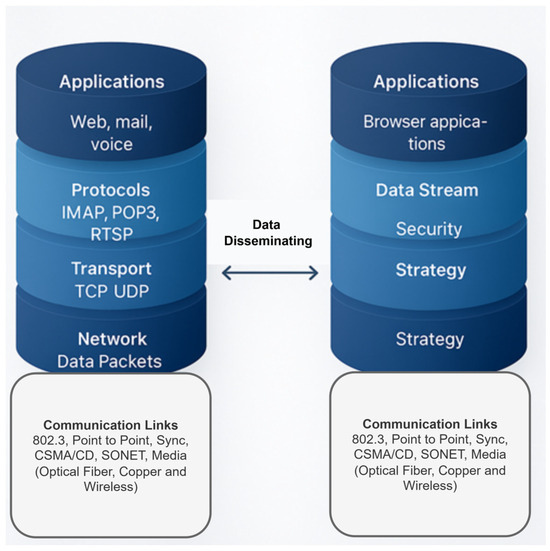
Figure 1.
Comparison of protocol suit (TCP/IP and Named Data Network protocol architecture).
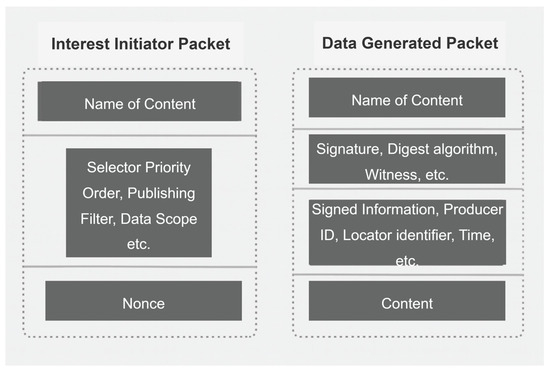
Figure 2.
NDN packet architecture.
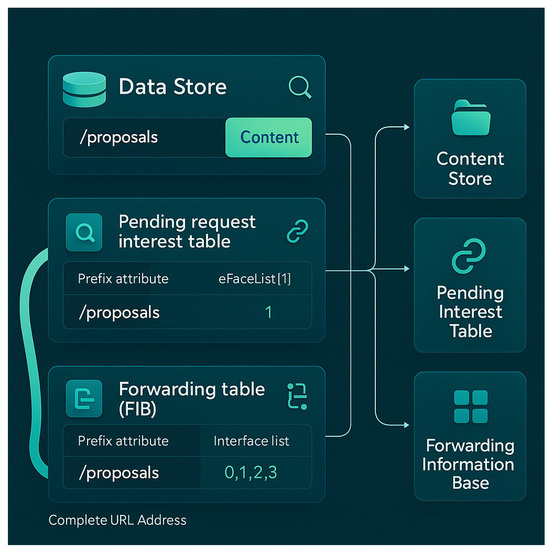
Figure 3.
CS table.
NDNs are facing some key challenges like scalability, security, interoperability, management of naming conventions, and development of applications, which are addressable. The key issues are proper naming and the mechanisms of caching and content delivery to the requester. Multiple naming conventions and effective caching mechanisms are proposed to address the efficiency of content retrieval in conjunction with social awareness and clustering [11]. Despite the promise of the CCN, challenges such as ineffective dynamic cache placement, high resource consumption under load, and a lack of context-aware decisions limit its scalability. SARAC4N targets these issues by leveraging cluster-based caching and social centrality-based cache selection.
While traditional mechanisms in ICN address resource optimization to some extent, they often overlook the integration of social factors and the strategic placement of caching nodes within dynamically formed clusters. This study introduces SARAC4N, a novel framework that combines social awareness (via node centrality and interaction metrics) with available computational resources (CPU, memory, storage, and link capacity) to enhance caching decisions. The proposed model reduces data retrieval time, minimizes error rates, lowers content duplication, and improves overall network efficiency. By integrating social context and clustering techniques, SARAC4N significantly enhances ICN performance compared to conventional approaches [12].
While SARAC4N integrates both social awareness and resource utilization, we acknowledge that some recent studies [13,14,15] and also other studies such as [16,17,18,19,20], have begun addressing resource-aware strategies in ICN. However, these approaches often overlook the dynamic and social contextual dimensions embedded within node interactions in clustered environments.
This research introduces SARAC4N, a novel framework that advances Content-Centric Networking through five key innovations. First, we develop a social-aware clustering approach that groups nodes based on social relationships and communication proximity, utilizing centrality measures (degree, betweenness, and closeness) rather than simple topological characteristics. This ensures that nodes with similar content interests are strategically grouped, maximizing cache efficiency and minimizing redundant distribution. Second, we introduce an intelligent dual-leadership architecture featuring resource-aware cluster head selection based on computational power, memory capacity, storage availability, and bandwidth. The framework establishes both primary cluster heads and backup nodes, creating fault-tolerant hierarchies that ensure continuous service availability and eliminate single points of failure. Third, SARAC4N implements dynamic content allocation that adapts to real-time network conditions and user behavior patterns. Unlike static caching policies, our context-aware placement mechanism considers node relevance, historical request patterns, and geographical proximity to strategically position content at socially central nodes. Fourth, we integrate advanced congestion detection using reinforcement learning for optimal traffic distribution. The system proactively monitors resource utilization, predicts potential bottlenecks, and intelligently redistributes requests to secondary heads or neighboring nodes while continuously improving through pattern learning. Finally, comprehensive evaluation across diverse topologies demonstrates SARAC4N’s superior performance with a 30–50% improvement in memory efficiency and up to a 40% reduction in retrieval times compared to baseline approaches. The framework consistently outperforms existing methods across cache hit ratios, content redundancy, error rates, and network throughput, establishing SARAC4N as a comprehensive solution addressing multiple networking challenges simultaneously. In the context of networking, social awareness refers to the ability of nodes to make caching and routing decisions based on their interaction frequency, structural importance (centrality), and communication patterns within the network. These relationships are modeled using social metrics such as degree, betweenness, and closeness centrality.
Unlike prior socially aware caching frameworks that focus narrowly on node popularity or mobility patterns (e.g., vehicular networks), SARAC4N integrates both resource profiling and social context within a cluster-based caching structure. It is unique in incorporating backup cluster heads, a dynamic workload distribution, and context-aware caching using centrality-driven selection criteria.
This work is motivated by the central question: How can Content-Centric Networking be improved using socially aware and resource-optimized clustering and caching mechanisms to support scalable, low-latency data access in dynamic and resource-constrained environments such as IoT and multimedia-rich networks?
This paper is organized as follows: Section 1 contains the Introduction; Section 2 describes related work in the same field; Section 3 explains the methodology and working mechanics of SARAC4N; Section 4 describes the performance metrics; and Section 5 presents the conclusion and future work.
To enhance clarity, Table 1 provides definitions for all major acronyms used throughout the manuscript. This will help readers follow the proposed framework and comparative methods without ambiguity.

Table 1.
Definitions of acronyms used in the paper.
2. Literature Review
In-network storage plays a crucial role in Information-Centric Networking (ICN), significantly improving data delivery speeds compared to traditional internet caching mechanisms. Data is no longer dependent solely on the original content provider; rather, it is temporarily stored in nodes distributed near to users, reducing the need for extensive communication and storage resources. Caching stands as the primary feature of ICN; research continues to focus on refining caching techniques. Figure 4 shows the The progression historically.
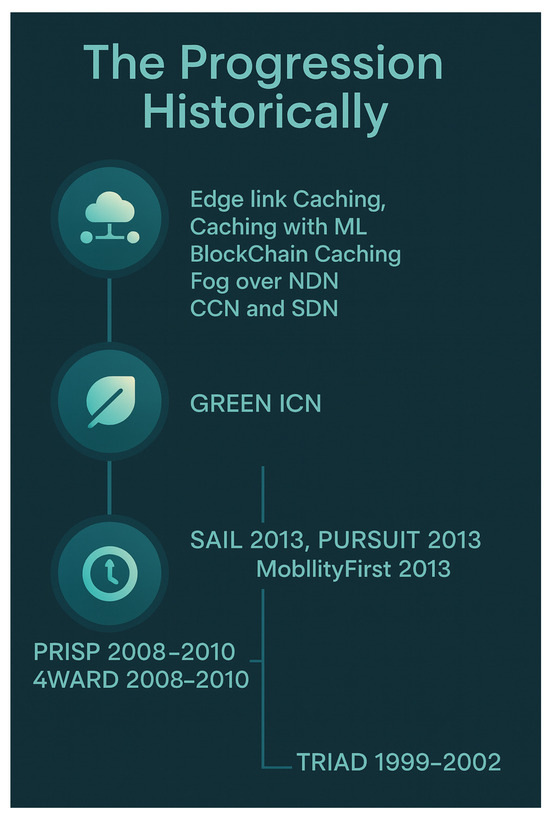
Figure 4.
The progression historically.
The idea of ICN was introduced in the Translating Relaying Internet Architecture integrating Active Directories (TRIAD) in 1999. Since then, name-based routing has evolved through many projects, such as the Data-Oriented Network Architecture (DONA). The major contribution was made by U.S.-funded initiatives like Named Data Networking (NDN) and MobilityFirst. Other notable efforts include COMET, PURSUIT, SAIL, GreenICN, 4WARD, and ICN-2020 [13]. Amongst these strategies, Content-Centric Networking (CCN) [14] has appeared as a pivotal ICN model by employing Interest and Data packets for effective content fetching. ICN addresses many complexities in conventional IP networks, such as mobility, crowdedness, security, scalability, and adaptability.
Information is distinguished by names and retrieved via obvious requests with a unique approach called pervasive caching. The outcome leads to the development of various caching mechanisms such as cooperative caching, non-cooperative caching, on-path caching, and off-path caching. These strategies are generally divided into five main categories.
2.1. Location-Based Caching
Location-based caching strategies aim to store data at specific nodes across the network to optimize retrieval latency. Several techniques have emerged in this category. Hash-Routing applies hash functions on data identifiers to direct requests toward specific caches, while Cooperative In-Network Caching (CIC) distributes content in equal portions across multiple routers to increase availability and balance load. ProbCache introduces a probabilistic content placement approach along the request path to minimize redundancy. Techniques like Breadcrumbs offer best-effort retrieval by tracking the content path, and the Chunk Caching Location and Searching Scheme (CLS) retains a historical footprint of content access to guide future retrievals. While these methods improve local accessibility and reduce repeated data fetching, they are inherently static and lack adaptability to dynamic social behaviors, node interactions, and real-time resource availability. Moreover, they do not consider node importance or network centrality in cache decisions. These limitations highlight the need for socially and resource-aware strategies like SARAC4N that adapt caching based on both network topology and contextual relevance.
While location-based caching enhances content accessibility by strategically positioning data across specific nodes, it often lacks adaptability in dynamic network conditions. Techniques like Hash-Routing and CIC assume static or semi-static paths, which may result in underutilized caches or inefficient redirection under node failures. Moreover, these methods rarely account for node-level resource availability or contextual relevance of content. SARAC4N overcomes these limitations by integrating social awareness and real-time resource monitoring, allowing content to be cached not just at fixed locations but at socially and resource-optimal nodes, ensuring both resilience and efficiency.
2.2. Multi-Level Caching
Multi-level caching strategies aim to improve data availability by leveraging cache storage across different tiers of the network. One widely used approach, Leave Copy Everywhere (LCE), stores a copy of the requested content at every node along the delivery path. Although this method reduces content retrieval delays and overall bandwidth usage, it often leads to excessive data redundancy and inefficient cache utilization. To mitigate this, probabilistic caching (Prob) introduces randomness into caching decisions—allowing nodes to cache data with a predefined probability, thereby controlling content replication. More advanced hierarchical caching schemes, such as Collaborative Hierarchical Caching and Efficient Hierarchical Content Placement (EHCP), extend cache coordination across multiple network levels, optimizing both edge and core cache placements. However, these approaches often rely on static topologies and lack the ability to adapt based on node centrality, real-time resource availability, or social dynamics among nodes. SARAC4N addresses these gaps by introducing a dynamic, socially aware clustering mechanism that adapts cache placement not only by location but also by interaction relevance and resource capacity.
Although multi-level caching strategies such as LCE and EHCP improve data availability and reduce retrieval latency across hierarchical layers, they often lead to excessive redundancy and inefficient cache utilization, especially when storage resources are limited. Probabilistic variants partially address this by controlling replication rates, yet they lack intelligent decision-making based on network dynamics or node importance. SARAC4N surpasses these limitations by using social centrality metrics and resource profiling to selectively cache content in strategically influential nodes, significantly minimizing redundancy while preserving access efficiency.
2.3. Node-Based Caching
Node-based caching strategies focus on placing content at specific nodes based on their role in the data request path. A notable approach is Leave Copy Down (LCD), where content is stored at a node just one hop downstream from the requester, aiming to reduce retrieval time for repeated requests. Similarly, Move Copy Down (MCD) [15] relocates the cached content closer to the requester after each access, effectively minimizing duplication across the network. Another approach, Cache-Aware Target Identification (CATT), enhances efficiency by selecting cache locations along the original request path based on node relevance and availability. While these strategies improve responsiveness and reduce content fetching delays, they often operate independently of real-time resource usage and ignore the social significance of nodes in the network. They also lack flexibility in dynamic environments where node loads and roles frequently change. SARAC4N addresses these shortcomings by selecting cache nodes not only based on path proximity but also through social centrality metrics and available computational resources, ensuring intelligent, adaptive caching decisions.
Node-based caching methods like LCD, MCD, and CATT offer improved cache localization by moving content closer to the consumer, thereby lowering retrieval delays. However, these approaches often overlook the real-time load and resource constraints of the caching nodes, leading to potential bottlenecks and uneven resource usage. Moreover, their static movement rules are not adaptive to social interactions or communication frequency patterns. SARAC4N enhances node-based caching by combining network topology with social metrics and dynamic resource monitoring, enabling more intelligent and balanced cache placement decisions that adapt to both traffic and node health.
2.4. Popularity-Based Caching
Popularity-based caching strategies determine content placement based on its access frequency across the network. In these methods, frequently requested content is prioritized for caching to reduce latency and improve hit ratios. For instance, Optimal Cache Placement Based on Content Popularity (OCPCP) stores content once it surpasses a predefined popularity threshold. Common cache replacement policies such as Least Recently Used (LRU), Least Frequently Used (LFU), and Time-Aware LRU (TLRU) govern which content is retained or evicted based on usage statistics. Advanced frameworks like Network Coding-Based Cache Management (NCCM) integrate with Software-Defined Networking (SDN) 2.4 to enhance routing and caching through linear coding, while approaches like Wave segment content by access frequency. Other techniques, such as Most Popular Content (MPC) and Fine-Grained Popularity-Based Caching (FGPC), further refine decisions by accounting for cache storage limits or recent access patterns.
Several dynamic strategies have also emerged, including NICE [16], COMP, BRCC, Adept, CSCPUL, Fog Cache, CCAR, PCSBCC, DLRUK, Spatially Dispersed Cache, Progress Caching, Joint Cache, and Hybrid Coordination approaches [17,18]. However, most of these techniques overlook node-level resource constraints and social relationships, which can significantly impact caching efficiency in clustered environments. SARAC4N enhances traditional popularity-based approaches by combining content demand trends with social awareness and resource availability, enabling more context-aware and adaptive cache placement.
Popularity-based caching mechanisms, such as OCPCP, LFU, and FGPC, efficiently prioritize frequently requested content, thereby reducing retrieval time and improving cache utilization. However, these methods often rely on static or reactive popularity thresholds and fail to incorporate real-time user behavior or network context. This can lead to inefficient content placement when demand patterns shift rapidly. Additionally, they generally ignore node-level resource limitations and social influence in content dissemination. SARAC4N addresses these gaps by combining popularity cues with social centrality and resource metrics, enabling adaptive, relevance-aware content caching that reflects both demand and context.
2.5. Edge-/IoT-Based Caching
The Internet of Things (IoT) paradigm has transformed network architecture by interconnecting a wide array of heterogeneous devices such as smartphones, vehicles, industrial sensors, and household appliances into a unified data ecosystem. To handle the massive volume and real-time requirements of IoT-generated data, several edge-centric caching strategies have been proposed. Approaches like ClientCache, TCCN (Time-Constrained Caching in NDN), FMC (Fog-Based Multi-Layer Caching), and SleepCaching aim to store frequently accessed data closer to end devices, thereby reducing latency and backhaul congestion. These mechanisms improve data accessibility and support reachability across diverse node types, including low-power or intermittently connected devices.
Despite their benefits, most existing IoT caching schemes focus heavily on proximity and availability, without integrating social relevance, node importance, or resource state into their decision logic. As a result, they struggle with content duplication, inefficient cache usage, and poor adaptability in highly dynamic or dense environments. SARAC4N addresses these limitations by embedding socially aware clustering and resource-optimized cache placement into the IoT-edge context, enabling more intelligent, responsive, and scalable caching in distributed IoT networks.
Edge- and IoT-based caching strategies like ClientCache, FMC, and SleepCaching enhance latency reduction and local data availability across heterogeneous devices. Despite their effectiveness in decentralized environments, they often struggle with limited resource capacity, inconsistent connectivity, and lack of coordination between nodes. These approaches typically lack a global caching policy informed by social or cluster-level interactions. SARAC4N extends edge caching by introducing coordinated clustering, social-metric-guided cache node selection, and workload balancing, thereby improving data consistency, fault tolerance, and cache efficiency even in resource-constrained IoT scenarios.
ICN’s pervasive caching strategies characterize a major shift in how content is stored and retrieved, focusing on reducing data duplication, optimizing resource utilization, and improving content delivery mechanisms. By caching content closer to requesters and adopting intelligent caching strategies that can increase data retrieval time, the ICN proposes a more efficient, scalable, and adaptable network architecture. [19,20]
Recent work by Chen et al. [21] introduced a socially aware edge collaborative caching framework for the Internet of Vehicles, leveraging deep reinforcement learning and digital twin integration to enhance caching decisions. While this approach effectively integrates social assistance and predictive learning, it primarily focuses on vehicular mobility and latency in real-time transport systems. In contrast, SARAC4N generalizes the social-awareness model using centrality-based node scoring (degree, betweenness, and closeness) and resource profiling to support diverse clustered ICN environments. It operates independently of specific mobility models and is optimized for both intra- and inter-cluster content disbursement, enabling higher scalability and adaptability in heterogeneous networks.
2.6. Socially Aware and Resource-Aware Caching Frameworks
Recent frameworks have explored how social metrics and node-level resource availability can guide clustering and caching in CCN architectures. These approaches often incorporate node centrality, social closeness, or communication frequency to improve cache hit probability and reduce latency. However, most existing models (e.g., CCAR, PCSBCC, and DLRUK) either use static metrics or do not jointly optimize both social and resource aspects. In contrast, the proposed SARAC4N adopts a dual-metric system that integrates weighted social centrality (w-degree, w-betweenness, and w-closeness) with real-time node workload metrics to form adaptive clusters and intelligently place content. This balance of social context and resource constraints enables better workload distribution, energy efficiency, and user-centric data delivery.
Table 2 presents a comparative summary of selected recent studies in ICN caching, highlighting their core strategies, contextual awareness, and limitations in relation to SARAC4N.

Table 2.
Comparative summary of existing caching methods in ICN.
In reality, many state-of-the-art methods combine elements of popularity, mobility, and cooperation. SARAC4N is inherently hybrid, integrating both resource and social awareness with dynamic clustering, outperforming pure strategies.
3. Methodology
3.1. Model Concept
The conceptual foundation of SARAC4N is built upon the fusion of social awareness and resource awareness in Content-Centric Networking. The framework models each node in the clustered ICN environment as an intelligent agent with dynamic attributes—such as CPU, memory, and communication centrality—that influence its role in caching and forwarding decisions. The model assumes a heterogeneous network where content popularity, node connectivity, and load conditions vary over time. SARAC4N incorporates a weighted centrality-based ranking mechanism, which feeds into the cluster formation logic. Each cluster operates semi-autonomously under a dual-head (CH and CSH) structure, ensuring redundancy and fault tolerance. Load balancing is modeled via queue-based priority scheduling and workload reallocation policies, triggered upon exceeding an empirically defined resource utilization threshold (80%). This concept formalizes a distributed decision-making model that adapts in real time, allowing clusters to reconfigure under dynamic load and social interaction patterns. The model integrates five subsystems: (i) Social Metric Computation, (ii) Resource Profiling, (iii) Cluster Formation Logic, (iv) a Load Balancing Engine, and (v) a Cache Placement Strategy.
Figure 5 illustrates the sequential process of SARAC4N cluster formation. It begins with assessing node-level resource availability (CPU, memory, and bandwidth), followed by evaluating social metrics such as centrality scores. Based on the combined Social Importance Score (SIS), the most optimal nodes are selected to serve as cluster heads (CHs), secondary heads (CSHs), or caching nodes, enabling efficient, distributed content placement across the network.
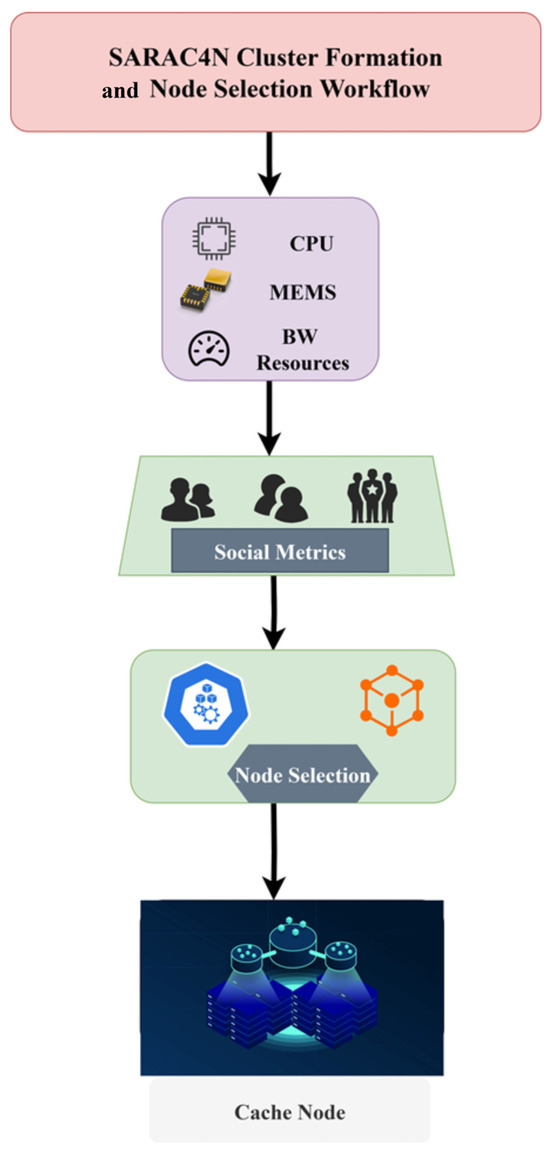
Figure 5.
SARAC4N cluster formation and node selection workflow.
3.2. Node Selection
Nodes are ranked based on communication degree, available interfaces, and previous content access logs. The node with the highest combined score is selected as the head. The node with the second-highest Social Importance Score (SIS) which still meets the minimum resource threshold is selected as the cluster secondary head (CSH) to ensure fault tolerance.
The selection of the node is a critical part of network caching strategies. A hybrid approach was chosen to implement the proposed methodology for the best and optimum results. The clusters of network nodes based on content similarity by keeping social awareness as a key factor are created first. Afterwards, a data node is selected for caching the demanded content due to its optimal position in the segment, which is calculated by using metrics like degree centrality, betweenness centrality, and closeness centrality. This selection process carries out the same operation to identify the primary and secondary cluster heads, as explained earlier, to assign the roles of the caching node, as well as its available resources, to ensure efficient content delivery. SARAC4N uses three main centrality metrics: degree (connectivity count), betweenness (routing potential), and closeness (distance to others). These metrics are normalized and aggregated to compute a node’s Social Importance Score (SIS), which informs its selection as a CH, CSH, or optimal cache node. Algorithm 1 shows the Distributed Node Role Assignment and Load Handling in SARAC4N.
| Algorithm 1: Distributed Node Role Assignment and Load Handling in SARAC4N |
| Each node executes the following algorithm periodically. |
| Input: |
| - Segment of nodes with varying resource capacities and request patterns; |
| - Local SIS components (degree, betweenness, and closeness). |
| Output: |
| - Elected CH/CSH roles, optimal caching decisions, and balanced workload. |
| 1. Initialization: |
| InitializeNodeParameters() |
| BroadcastNodeStatus() // share CPU, memory, SIS scores with neighbors |
| 2. Compute SIS (Social Importance Score): |
| SIS ← Normalize(DegreeCentrality, Betweenness, Closeness) |
| ShareSISWithNeighbors() |
| 3. Role Election: |
| If SIS = Max(SIS of neighbors): |
| AssignRole(Node, “Cluster Head (CH)”) |
| Else if SIS = SecondHighest(SIS of neighbors): |
| AssignRole(Node, “Cluster Secondary Head (CSH)”) |
| End If |
| 4. Caching Decision: |
| If Node is CH or PopularityScore > Threshold: |
| EnableCaching() |
| End If |
| 5. Monitor and Manage Requests: |
| While True: |
| ResourceCapacity ← GetAvailableResources(Node) |
| IncomingLoad ← MonitorIncomingRequests() |
| If IncomingLoad ≤ ResourceCapacity: |
| ProcessRequestsLocally() |
| Else: |
| ForwardTo(CSH or Neighbor with LowestLoad) |
| End If |
| UpdateCacheIfNeeded() |
| End While |
| 6. Dynamic Load Balancing: |
| Periodically: |
| For each Neighbor Node: |
| If NeighborLoad > LoadThreshold: |
| AssistLoadHandling(Neighbor) |
| End If |
| End For |
This algorithm monitors the resource capacity of nodes within a segment and dynamically redistributes workload if any node exceeds its threshold. It ensures optimal content caching and load balancing during ongoing operations.
3.3. Resource Allocation
Problem Definition:
In clustered networks, individual nodes often face resource exhaustion when subjected to high-frequency content requests, leading to performance degradation and network bottlenecks.
Proposed Strategy:
To mitigate this, SARAC4N introduces a collaborative load-sharing mechanism, where a designated cluster secondary head (CSH) supports the cluster head (CH) in dynamically distributing request loads. This strategy is particularly critical when a node’s utilization exceeds a defined threshold.
Resource Quantification:
Each node’s resource capacity is quantified as a weighted aggregate of available computing power (in GHz), memory (in MB), and bandwidth (in Mbps). A node is considered overloaded once its cumulative usage exceeds 80% of its capacity. The 80% resource utilization threshold is based on empirical observations in similar distributed caching studies, where nodes begin to show signs of delayed response and congestion beyond this point. This value balances responsiveness and resource usage without triggering excessive offloading.
Load Redistribution:
Upon overload detection, the workload is reassigned to the CSH or the nearest low-load node using a priority queue-based scheduling mechanism. This ensures continuous service availability and prevents any single point of failure. The mechanism works in real time and is designed to function in both static and dynamic cluster environments.
Resource capacity is measured as a weighted aggregate of available CPU (GHz), memory (MB), and network bandwidth (Mbps). A node’s threshold is defined as 80% of its total resource utilization. When usage exceeds this, workload is reassigned to the CSH or a neighboring node with the lowest current load, using a queue-based redistribution mechanism.
3.4. Congestion Shunning and NDN Function
Problem Definition:
Network congestion occurs when nodes receive a high volume of Interest packets beyond their processing and caching capacity, resulting in increased data retrieval delays and cache thrashing.
Congestion Management Strategy:
SARAC4N implements a proactive scanning mechanism at each node to evaluate available system resources in real time. If congestion is detected, the node forwards incoming requests to other candidate nodes within the cluster that are better equipped to handle the load.
Execution Workflow:
Each node assesses its current CPU, memory, and link utilization.
Requests exceeding the node’s threshold are rerouted to the CSH or neighboring node with the lowest active load.
Nodes store high-priority, frequently accessed content based on recent cache hit statistics to reduce repetitive traffic.
NDN Caching Enhancement:
To further reduce congestion and response latency, a dedicated cache node is selected within each cluster. This node stores non-replaceable and frequently requested content, ensuring quick access across the cluster while reducing PIT growth and FIB overhead. Figure 6 shows the SARAC4N framework illustrating the step-by-step formation of socially aware clusters, selection of primary and secondary cluster heads based on resource metrics, and neighbor cluster cooperation for popularity-driven content caching and efficient network coordination.
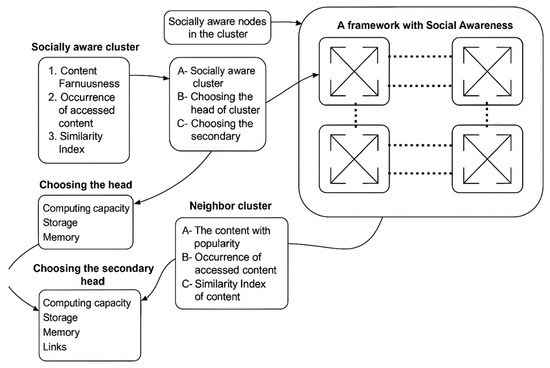
Figure 6.
SARAC4N framework illustrating the step-by-step formation of socially aware clusters, selection of primary and secondary cluster heads based on resource metrics, and neighbor cluster cooperation for popularity-driven content caching and efficient network coordination.
3.5. Cluster Formation and Management
We employ a static K-Means-based clustering algorithm to partition the network into manageable segments based on Euclidean distance and the Social Importance Score (SIS), which aggregates node centrality metrics (degree, betweenness, and closeness). Each cluster is anchored by a cluster head (CH) selected based on the highest SIS and optimal resource capacity (CPU, memory, and bandwidth). A cluster secondary head (CSH) is also designated to act as a real-time failover to maintain fault tolerance and ensure service continuity during node overload or failure. The clustering process is periodically refreshed every 1000 simulation ticks to accommodate dynamic changes in content demand and node status. To maintain scalability and balance, the cluster size is restricted to a maximum of 25 nodes, preventing over-centralization and uneven load distribution. This hierarchical and socially informed clustering mechanism enables efficient content placement, reduces inter-cluster congestion, and ensures resilience under varying network conditions.
- A.
- Clustering on the basis of social awareness
The degree of centrality: The centrality degree of a proposed data node in the suggested framework can be evaluated as in Equation (1):
An adjacency mechanism (A) is formulated, and the degree for the centrality of node n is ascertained by calculating the sum of horizontal (row) or perpendicular (column) factors relating to the endpoint, n (for an undirected graphical presentation).
where concludes with the evidence of a link among data nodes and in the contiguous matrix. is the overall figure of data caching data points in the network.
The degree of betweenness:
The total quantity of short paths comprised in an apex (x) is believed to be its betweenness centrality. It is explained as in Equation (3):
where is the total quantity of the shortest data paths between node and node is the number that presents the data paths which pass through the node .
The degree of closeness:
The degree of closeness for a node is the inverse of the total of the shortest data path distances from data node to all the others. The closeness is calculated as explained in Equation (4):
where denotes the shortest data path from nodes and .
The selection of nodes for optimization:
Inter-cluster communication ensures continuity when content is not available locally. It prevents request looping and enhances content diversity across clusters while reducing the average content distance.
The mechanism for selecting the optimum data node for the degree of betweenness and closeness centrality is implemented via a weighted combination and ordering of the centrality metrics, respectively. For instance, a ranked sum is explained in Equation (5):
where , and is the closeness degree, where ranks are affiliated with each degree measure, explaining their corresponding value of importance.
The weights for w-degree, w-betweenness, and w-closeness were empirically tuned using a simulation-based grid search. Initial values were set equally (0.33 each), and incremental adjustments were made based on the cache hit ratio and retrieval latency. The final weights used were as follows: w-degree = 0.4, w-betweenness = 0.3, and w-closeness = 0.3, prioritizing connectivity slightly more.
While static K-means clustering is used in the current implementation for initial simplicity and reproducibility, we acknowledge the inherent dynamism of IoT networks. To partially address this, the clusters are refreshed periodically (every 1000 simulation ticks). Future work may incorporate real-time, mobility-aware re-clustering strategies using fuzzy or online K-means variants to enhance adaptability.
- B.
- Allocation of Resources
The proposed setup explains a state where the quantity of incoming data requests is more than the capacity of the respective data node. To address this problem, the secondary node performs as a backup to the primary node and takes care to disperse the information in the segmented cluster. Load is shared, resources are shared, and as a result the overhead is reduced at both nodes.
Let us assume a simple model:
Let Lr represent the total amount of incoming requests in term of load. Assume that Com denotes the computational capacity, device memory, device storage, and capacity of the network with respect to the performance at a node.
Let Lc signify the grave threshold when the data node is choked. The following equation explains the status of a possible process of choking:
The equation presents Lr > Com in a binary situation if the total number of requests, Lr, is bigger than the capability of a serving data node, Com, such that the possibility of having constraint Com could be faced; otherwise, a constraint, Lc, does not seem possible.
- C.
- Performance metrics
This section explains the performance variations of key metrics explored to compare the advanced network architectures with traditional TCP/IP systems.
Data Retrieval Time: This is the time consumed to fetch the data after a request is initiated. It indicates how efficiently data can be accessed but could be determined by factors like network topology, caching strategies, and routing protocols.
Throughput: This assesses the volume of data transmitted via a network per unit of time. It is a very important indicator of how the network handles varying load conditions but also depends on the network capacity and efficiency.
The Ratio of Cache Hits: The ratio of hits in the cache evaluates the efficacy of caching within a network and also reflects the portion of incoming requests served from the cache rather than the original source where the data was originally placed.
Error Rates: Error rates can be defined as the occurrences of errors in data during transmission in a network. Lower error rates represent higher network performance.
Resource Utilization: This metric helps to evaluate how efficiently a network uses its resources, such as network bandwidth, computation, and storage. Proper resource management is key to high performance and scalability, specifically in networks.
Network Congestion: Network congestion occurs when the amount of data received exceeds the capacity of the available bandwidth of links in the network. It gives insights into real-time data traffic being received at links. Understanding congestion helps in evaluating the network’s capacity to maintain performance.
- D.
- Performance Evaluations
The simulation methodology employed in this study utilized the NDN Simulator to comprehensively evaluate network performance under diverse operational conditions. The experimental environment was established on a Linux-based system running Ubuntu 20.04, leveraging the NS-3 network simulator integrated with ndnSIM for Named Data Networking implementations. The hardware configuration consisted of an Intel i7 8th generation processor, 16 GB RAM, and 120 GB storage capacity, providing sufficient computational resources for extensive simulation campaigns. The evaluation framework incorporated three distinct network topologies to assess the generalizability and robustness of the proposed SARAC4N framework. These topologies included hierarchical structures that mimic enterprise or campus networks with tiered traffic patterns, grid configurations representative of structured environments such as smart grids or urban sensor networks, and random topologies that reflect the unpredictable nature of dynamic IoT and peer-to-peer systems. Each topology was configured with cache-enabled routers, consumer nodes, and producer nodes to simulate realistic content distribution scenarios. Network parameters were standardized across all experimental scenarios to ensure consistent comparative analysis. Link configurations maintained a 1% packet loss ratio, 10 ms delay, and 100 Mbps bandwidth capacity, reflecting typical network conditions encountered in real-world deployments. These parameters provided a controlled environment for evaluating the performance characteristics of different caching strategies under comparable conditions. The simulation campaign encompassed multiple stress-testing scenarios designed to evaluate network resilience and adaptability. High-network-load conditions were systematically applied to assess the system’s ability to maintain performance under increased traffic volumes while preserving acceptable delay characteristics. Node failure scenarios were implemented to examine network vulnerability and recovery mechanisms, providing insights into the fault tolerance capabilities of the proposed clustering approach. Comprehensive caching strategy comparisons were conducted through detailed analysis of cache hit and miss ratios during content retrieval operations, enabling quantitative assessment of storage efficiency and content availability. Real-time monitoring of data delivery times from consumer to producer nodes provided critical insights into overall network efficiency and responsiveness. The evaluation framework specifically examined load balancing and resource sharing mechanisms to assess their effectiveness in preventing network congestion and optimizing resource utilization. Additionally, comprehensive analysis of data transmission errors and content redundancy patterns was conducted to evaluate the reliability and efficiency of the proposed socially aware caching approach. The extensive simulation results demonstrated that Named Data Networking, particularly when enhanced with the SARAC4N framework, offers significant advantages over conventional IP-based networks. The findings revealed measurable improvements in network performance and efficiency, characterized by reduced data error rates and minimized data retrieval times across various operational scenarios and network topologies.
4. Results and Discussion
The comparison of the caching schemes with respect to the identified metrics is presented in graphs. A very clear and strong analysis with deep insights into network efficiency and performance is demonstrated in this research. SARAC4N beats the all-caching strategies, and empirical results show that SARAC4N’s socially aware caching approach’s capability is far better for optimizing network paths, reducing bottlenecks, and enhancing user experience.
To quantitatively evaluate SARAC4N, several key performance metrics were considered. These included data retrieval time, memory utilization, error rate, average content distance, and cache store changes. Table 3 summarizes each metric and its purpose within the evaluation framework.

Table 3.
Description of performance metrics used in SARAC4N evaluation.
4.1. Data Retrieval Time
The “Data Retrieval Time” graph in Figure 7 compares the four caching schemes, MCD, LCD, CCndns, and SARAC4N. SARAC4N constantly outclassed its competitors in data retrieval time; MCD showed comparatively better values. LCD consistently took more time to retrieve the data, while CCndnS gave abrupt variations. SARAC4N stayed at the top with a shorter data fetching time. Clustering with the SAC mechanism aligned itself perfectly with the partitioning, where CH and CSH selection streamlined the data retrieval processes more quickly. Additionally, the social engagement metric with respect to the node’s position in the cluster significantly lowered the latency and increased efficiency in data fetching time.
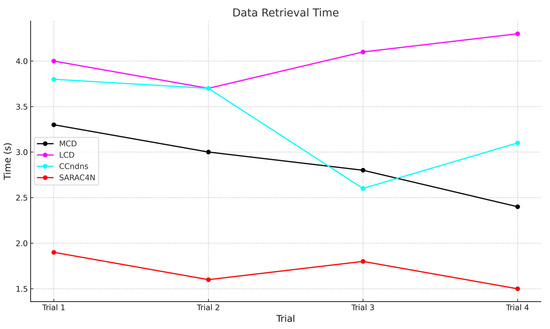
Figure 7.
Data retrieval time comparison across caching mechanisms.
4.2. Performance
The “CPU Utilization” graph in Figure 8 presents the percentage of computation against data requests with four caching mechanisms. The SARAC4N mechanism outperformed its counterparts with a very obvious margin with lesser CPU utilization. MCD and LCD took more computation to process the incoming requests, while CCndnS performed a little better.
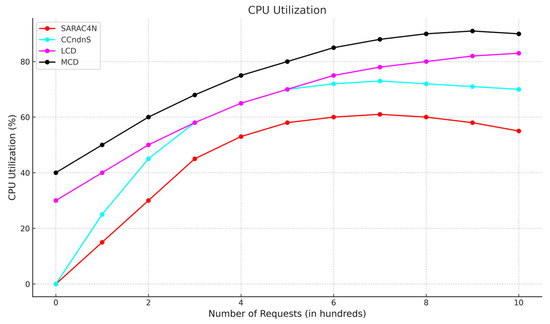
Figure 8.
PU utilization comparison across caching schemes (SARAC4N, CCndnS, LCD, and MCD) with increasing request load. CPU: Central Processing Unit. CCndnS: Centralized Cooperative Named Data Scheme.
The simulation was conducted using ndnSIM on NS-3. Each network topology was simulated with 50 nodes (including 40 consumers and 10 producers), and each content file was set at a uniform size of 1 MB. Content request rates were generated following a Zipf distribution with parameter , representing skewed user demand. The simulations ran for 1000 s per scenario, and performance was tested under increasing node counts (50, 100, and 150 nodes) to evaluate scalability.
This presentation identifies that the other schemes might not be as effective as SARAC4N due to their straightforward handling mechanisms. They lack the dynamic feature of managing resources. Figure 8 shows the PU utilization comparison across caching schemes (SARAC4N, CCndnS, LCD, and MCD) with increasing request load. CPU: Central Processing Unit. CCndnS: Centralized Cooperative Named Data Scheme.
4.3. Memory Utilization
The “Memory Utilization” graph in Figure 9 presents the direct association of memory utilization and the quantity of received data requests. MCD, LCD, CCndnS, and SARAC4N were compared with the same thresholds. SARAC4N’s segmentation mechanism accomplishes efficiency by caching the most popular and socially aware content. All strategies are far behind in comparison with SARAC4N. MCD stays at 60% utilization consistently, LCD varies between 40% and 65%, and CCndnS stays at 60%, while SARAC4N starts at 20% and stabilizes at 40%.

Figure 9.
Memory utilization (%) across varying request loads. SARAC4N shows consistently lower usage compared to CCndnS (Content-Centric Named Data Networking with Social Awareness), LCD (Least-Cost Data), and MCD (Most Centralized Data).
The graph shows that SARAC4N’s strategy of creating clusters on the bases of measuring the social metrics and storing the content on the same basis in neighboring nodes proves its responsiveness along with lesser utilization of resources.
4.4. Error Rate
The error rate graphs in Figure 10 present four trials against different methodologies. SARAC4N is compared with CCndnS, LCD, and MCD. It consistently shows reduced data choking points, suggesting that it successfully manages volumes of data with higher efficacy. This aligns with the cluster-based approach highlighted in previous research, where SARAC4N likely incorporates socially aware caching to optimize data routes and minimize bottlenecks. LCD, on the other hand, exhibits a notable result in the third trial, indicating that it is less adaptable than SARAC4N when it comes to handling sudden spikes in network demand.
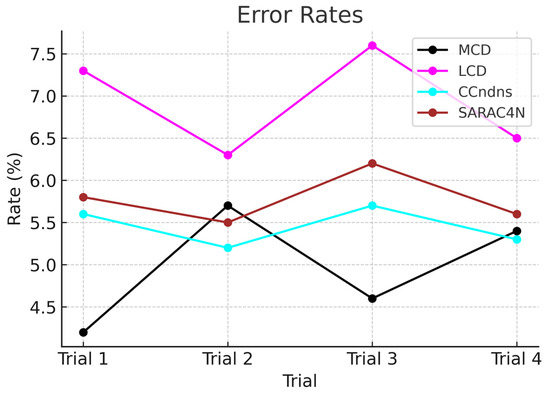
Figure 10.
Error rate comparison of caching schemes (SARAC4N, CCndns, LCD, and MCD) across four trials. LCD: Least Recently Cached Data; MCD: Most Centralized Data.
SARAC4N demonstrates low and stable error rates, especially compared to MCD and LCD, which show significant fluctuations across the trials. This consistent performance by SARAC4N may be due to its robust clustering and caching strategies due to social factors and ideal network positioning. By these means, SARAC4N reduces errors stemming from inaccurate predictions or misallocated cache storage.
4.5. Probability of Data Finding
The “Probability of Cache Hit” graph in Figure 11 presents the likelihood of retrieving content from the cache of the nearby or local node. SARAC4N stands out with a very high cache hit probability and remains stable due to its social awareness capability, while MCD and CCndnS rank lowest. Socialness has proved to be very critical in cache-based decisions for the relevance of content.
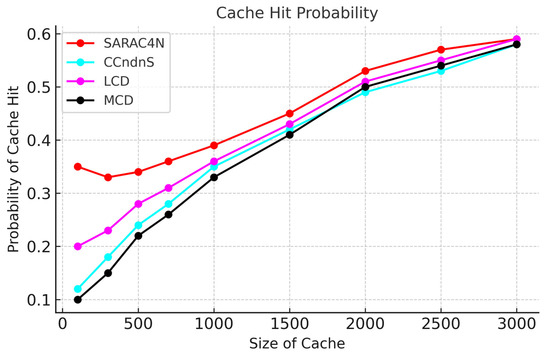
Figure 11.
Cache hit probability versus cache size for SARAC4N and baseline caching schemes (MCD, LCD, and CCndnS). SARAC4N consistently achieves superior performance, especially in mid-sized caches.
4.6. Average Content Distance
The “Average Content Distance” graph in Figure 12 shows the numbers of hops required to fetch the desired content from the data origin. SARAC4N has shortest content distance across multiple cache sizes, starting from eight hop counts to four hop counts, as it proposes to store data on the basis of social awareness and the location of the requester. CCndnS, LCD, and MCD have higher hop counts. The graph explains how the proposed SARAC4N methodology precisely pinpoints the destination node and manages user requests by considering its cluster-based and social-factor-based management mechanism. This approach has predominantly benefited high-traffic networks, as it ensures faster and more efficient access to the required information in a shorter time.
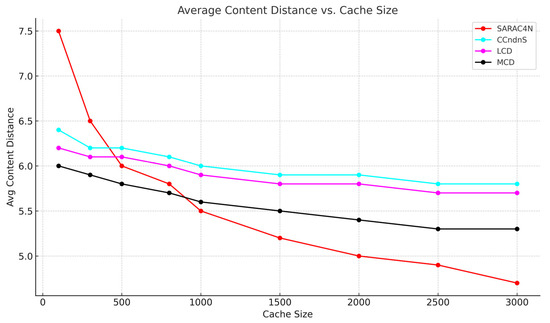
Figure 12.
Comparison of average content distances across cache sizes for SARAC4N, CCndnS, LCD, and MCD strategies.
4.7. Content Store Changes
The graph of “CS Search” in Figure 13 exposes the number of explorations in the data store, which can be changed if the size of the store or the content itself is different. As per received number of requests, both SARAC4N and CCndnS present the high search activity. On the other hand, LCD and MCD show minimal searches, indicating a more static approach to caching with limited updates and content checks.
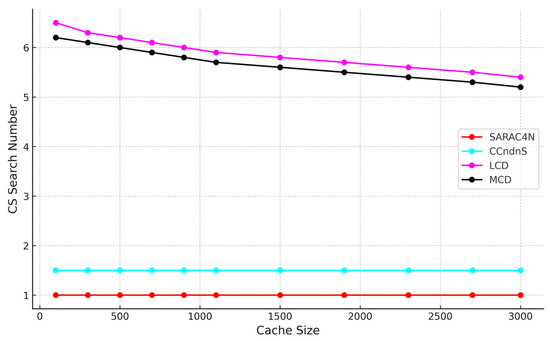
Figure 13.
Comparison of CS search frequency versus cache size across SARAC4N, CCndnS, LCD, and MCD strategies.
It is obvious from these graphs that an effective caching and data storage strategy can enhance efficiency in data retrieval along with other important metrics. SARAC4N explicitly outperformed its peers through its lower data redundancy and maintained a high number of searches, as well keeping the most required data in its cache and removing unneeded content from store and saving storage. The steady search numbers for SARAC4N and CCndnS suggest that their cache management is sophisticated, precise, proactive, and responsive.
4.8. Topology-Specific Analysis
To assess the generalizability and adaptability of SARAC4N, simulations were conducted using three distinct topologies: hierarchical, grid, and random topologies. Each topology emulates a different real-world deployment scenario. The hierarchical topology resembles enterprise or campus networks, where traffic is tiered and structured. The grid topology mimics structured environments like smart grids or urban sensor networks, while the random topology reflects dynamic and less predictable IoT and peer-to-peer (P2P) systems.
Across these topologies, SARAC4N consistently outperformed traditional caching methods in terms of cache hit ratio, CPU utilization, and data retrieval time. In the hierarchical setup, SARAC4N leveraged socially aware clustering to minimize inter-tier communication delays. In the grid topology, the structured layout allowed SARAC4N’s resource optimization to enhance spatial locality, reducing redundant caching. The random topology posed more unpredictable challenges, yet SARAC4N still maintained performance stability due to its dynamic node selection and backup strategies via cluster secondary heads.
The results confirm SARAC4N’s robustness and adaptability in heterogeneous network conditions, demonstrating its suitability for both static and dynamic real-world environments.
The benchmarking schemes used for comparison included LCD, MCD, CCdnS, CSQR, and CB-PC-DMM. These represent traditional caching mechanisms that optimize content placement based on basic principles like node hierarchy, proximity, and probabilistic popularity. In contrast, SARAC4N enhances performance by integrating social awareness, resource optimization, and dynamic cluster-based management, which collectively reduce latency, improve memory utilization, and lower content redundancy. The results show that SARAC4N outperforms all benchmarks by delivering a more adaptive and context-aware caching framework under varying network conditions.
4.9. Baseline Methods
To benchmark the effectiveness of the proposed SARAC4N framework, we compared its performance with several existing caching strategies widely referenced in the literature. The CCndnS scheme operates as a coordinated caching mechanism that leverages content popularity and node hierarchy, placing frequently requested data closer to the requesting nodes to minimize retrieval latency. The CSQR (Cluster-Based Socially Aware Query Routing) approach utilizes social interaction graphs and content affinity scores to guide Interest packet forwarding and determine cache placement across clusters, aiming to improve content relevance and delivery efficiency. The CB-PC-DMM (Centrality-Based Popularity-Centric Dynamic Memory Management) model combines node centrality metrics (e.g., degree and betweenness) with content popularity trends to dynamically adjust memory allocation and optimize cache storage across the network. These baseline schemes represent a diverse set of strategies focused on popularity awareness, social relevance, and adaptive caching, and were selected to provide a well-rounded comparative evaluation against the proposed SARAC4N mechanism.
While the current study is based on simulations in NS3 due to the scale and flexibility of parameter control, we acknowledge the necessity of validating SARAC4N in real-world environments. A real deployment scenario involving a campus-wide IoT deployment and multimedia content dissemination is under consideration. Future work will include benchmarking SARAC4N against existing caching strategies using real traffic data, latency logs, and bandwidth utilization metrics under identical environmental conditions to ensure generalizability and system resilience.
5. Conclusions
This paper introduced SARAC4N, a socially and resource-aware caching strategy tailored for clustered Content-Centric Networks (CCNs). Through extensive simulation-based evaluations across diverse network topologies and performance metrics, SARAC4N consistently outperformed existing schemes in terms of data retrieval time, memory efficiency, content duplication, and resource-aware content placement. The framework demonstrated effective clustering, efficient utilization of computational and storage resources, and incorporation of social–contextual factors for adaptive caching. Moreover, SARAC4N proved its robustness and adaptability in dynamic and heterogeneous environments, confirming its suitability for large-scale, data-intensive applications such as IoT networks and smart cities. Despite these promising results, there remains room for future enhancements. The current framework assumes static cluster configurations; hence, integrating support for cluster mobility and real-time re-clustering will be essential for applications with frequently changing content and user mobility. Additionally, embedding AI/ML-driven decision-making can enhance the intelligence and responsiveness of caching operations, particularly in latency-sensitive domains like the Tactile Internet. Despite its promising results, SARAC4N has several limitations. First, it currently employs static clustering, which may not adapt optimally to highly dynamic environments. Second, the framework has only been evaluated via simulation, and real-world deployment or testbed validation is pending. Finally, the current design lacks explicit support for mobility-aware cache updates or handovers.
Author Contributions
Methodology, A.R.K.; Formal analysis, U.S.; Resources, U.S.; Data curation, H.B.L. All authors equally contributed. All authors have read and agreed to the published version of the manuscript.
Funding
This research received no external funding.
Data Availability Statement
The data presented in this study are available on request from the corresponding author.
Conflicts of Interest
The authors declare no conflict of interest.
References
- Asaeda, H.; Matsuzono, K.; Hayamizu, Y.; Hlaing, H.H.; Ooka, A. A survey of information-centric networking: The quest for innovation. IEICE Trans. Commun. 2024, 107, 139–153. [Google Scholar] [CrossRef]
- Beri, S.S.; Dutta, N.; Delavadia, K. Content Retrieval in Information Centric Networks Using Machine Learning Models. In Proceedings of the 2024 International Conference on Emerging Techniques in Computational Intelligence (ICETCI), Hyderabad, India, 22–24 August 2024; pp. 66–73. [Google Scholar]
- Glazkov, R.; Moltchanov, D.; Srikanteswara, S.; Samuylov, A.; Arrobo, G.; Zhang, Y.; Feng, H.; Himayat, N.; Spoczynski, M.; Koucheryavy, Y. Provisioning of Fog Computing over Named-Data Networking in Dynamic Wireless Mesh Systems. Sensors 2024, 24, 1120. [Google Scholar] [CrossRef] [PubMed]
- Zou, H.Y.; Wang, H.J.; Sheng, Z.; Liu, W.; Jiang, F. When is more (not) better? On the relationships between the number of information ties and newcomer assimilation and learning. Hum. Resour. Manag. J. 2024, 34, 1080–1111. [Google Scholar] [CrossRef]
- Akmal, I.; Khan, H.; Khushnood, A.; Zulfiqar, F.; Shahbaz, E. An efficient artificial intelligence (Al) and blockchain-based security strategies for enhancing the protection of low-power loT devices in 5G networks. Spectr. Eng. Sci. 2024, 2, 528–586. [Google Scholar]
- Song, J.; Yang, Y.; Jin, W.; Song, T. Adaptive Segmented Subscription for Efficient Data Dissemination in Vehicular Named Data Networks. IEEE Trans. Netw. Serv. Manag. 2024, 21, 4466–4479. [Google Scholar] [CrossRef]
- Wang, X.; Chen, X.; Wang, X. Secure vehicular data communication in Named Data Networking. Digit. Commun. Netw. 2023, 9, 203–210. [Google Scholar] [CrossRef]
- Stocchero, J.M.; Carneiro, A.D.; Zacarias, I.; de Freitas, E.P. Combining information centric and software defined networking to support command and control agility in military mobile networks. Peer-to-Peer Netw. Appl. 2023, 16, 765–784. [Google Scholar] [CrossRef]
- Rehman, M.A.U.; Ullah, R.; Kim, B.S. NINQ: Name-Integrated Query Framework for Named-Data Networking of Things. Sensors 2019, 19, 2906. [Google Scholar] [CrossRef] [PubMed]
- Karrakchou, O.; Samaan, N.; Karmouch, A. FCTrees: A Front-Coded Family of Compressed Tree-Based FIB Structures for NDN Routers. IEEE Trans. Netw. Serv. Manag. 2020, 17, 1167–1180. [Google Scholar] [CrossRef]
- Yoshida, M.; Ito, Y.; Sato, Y.; Koga, H. PopDCN: Popularity-aware dynamic clustering scheme for distributed caching in ICN. IEICE Trans. Commun. 2024, 107, 398–407. [Google Scholar] [CrossRef]
- Asmat, H.; Din, I.U.; Almogren, A.; Altameem, A.; Khan, M.Y. Enhancing Edge-Linked Caching in Information-Centric Networking for Internet of Things with Deep Reinforcement Learning. IEEE Access 2024, 12, 154918–154932. [Google Scholar] [CrossRef]
- Ali, M.N.; Zahary, A.T.; Areqi, M.A. IP and ICN Networking in D2D_IoT Communications: A Comparative Study. Sana’a Univ. J. Appl. Sci. Technol. 2024, 2, 158–167. [Google Scholar] [CrossRef]
- Siddiqa, A.; Qureshi, F.F.; Shah, M.A.; Iqbal, R.; Wahid, A.; Chang, V. CCN: A novel energy efficient greedy routing protocol for green computing. Concurr. Comput. Pract. Exp. 2018, 31, 4461. [Google Scholar] [CrossRef]
- Laoutaris, N.; Che, H.; Stavrakakis, I. The LCD interconnection of LRU caches and its analysis. Perform. Eval. 2006, 63, 609–634. [Google Scholar] [CrossRef]
- Khan, J.A.; Westphal, C.; Garcia-Luna-Aceves, J.J.; Ghamri-Doudane, Y. Nice. In Proceedings of the 5th ACM Conference on Information-Centric Networking–ICN ‘18, Boston, MA, USA, 21–23 September 2018. [Google Scholar]
- Yan, Z.; Park, Y.-J.; Leau, Y.-B.; Ren-Ting, L.; Hassan, R. Hybrid Network Mobility Support in Named Data Networking. In Proceedings of the 2020 International Conference on Information Networking (ICOIN), Barcelona, Spain, 7–10 January 2020; pp. 16–19. [Google Scholar]
- Meng, Y.; Ahmad, A.B. Performance Measurement Through Caching in Named Data Networking Based Internet of Things. IEEE Access 2023, 11, 120569–120584. [Google Scholar] [CrossRef]
- Systems, C. Cisco Annual Internet Report (2018–2023). White Paper, Mar. 2023. [Online]. Available online: https://www.cisco.com/c/en/us/solutions/executive-perspectives/annual-internet-report/index.html (accessed on 20 May 2025).
- Leite, E. Quest for knowledge: The tenacity behind innovation. J. Entrep. Res. 2024, 2, 1–3. [Google Scholar] [CrossRef]
- Chen, G.; Duan, W.; Sun, J.; Zeng, Q.; Zhang, Y.D. Social-aware assisted edge collaborative caching based on deep reinforcement learning joint with digital twin network in Internet of Vehicles. IEEE Trans. Intell. Transp. Syst. 2024, 25, 14785–14802. [Google Scholar] [CrossRef]
Disclaimer/Publisher’s Note: The statements, opinions and data contained in all publications are solely those of the individual author(s) and contributor(s) and not of MDPI and/or the editor(s). MDPI and/or the editor(s) disclaim responsibility for any injury to people or property resulting from any ideas, methods, instructions or products referred to in the content. |
© 2025 by the authors. Licensee MDPI, Basel, Switzerland. This article is an open access article distributed under the terms and conditions of the Creative Commons Attribution (CC BY) license (https://creativecommons.org/licenses/by/4.0/).